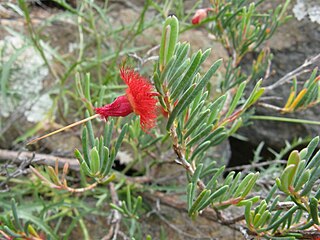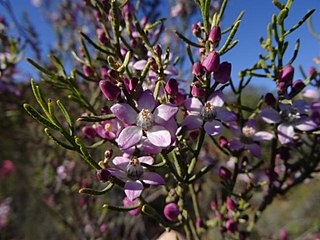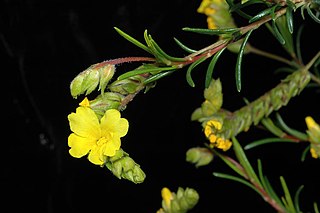
Eremophila oldfieldii, commonly known as pixie bush, is a flowering plant in the figwort family, Scrophulariaceae and is endemic to Western Australia. It is a shrub or small tree with rough bark, broad, flat or narrow fleshy leaves and red, orange or yellow flowers.

Grevillea plurijuga is a species of flowering plant in the family Proteaceae and is endemic to southern Western Australia. It is a prostrate to low-lying or dense mounded to erect shrub with divided leaves with linear lobes and loose clusters of hairy, red or pink flowers.
Grevillea nematophylla, commonly known as water bush or silver-leaved water bush, is a species of flowering plant in the family Proteaceae and is endemic to Australia. It is shrub or small tree with simple or pinnatisect leaves, the leaves or lobes linear, and branched, cylindrical clusters of cream-coloured flowers.

Eremophila willsii is a flowering plant in the figwort family, Scrophulariaceae and is endemic to Australia. It is an erect shrub with bright green, often serrated leaves and pinkish to deep pinkish-purple petals. It is mainly found in Western Australia, the Northern Territory and South Australia in deep sand.
Verticordia comosa is a flowering plant in the myrtle family, Myrtaceae and is endemic to the south-west of Western Australia. It is an openly branched shrub with small, broad, almost round leaves and spikes of flowers that are pale yellow, sometimes with a white or pale pink centre.

Verticordia densiflora, commonly known as compacted featherflower, is a flowering plant in the myrtle family, Myrtaceae and is endemic to the south-west of Western Australia. It is a shrub with small leaves, usually small pink and white flowers and which is widespread in the south-west of the state. It is a variable species and in his 1991 paper, Alex George formally described five varieties.

Verticordia fimbrilepis, commonly known as shy featherflower, is a flowering plant in the myrtle family, Myrtaceae and is endemic to the south-west of Western Australia. It is a small, bushy shrub with one openly branched main stem at its base, small, pointed leaves and rounded groups of pink flowers near the ends of the branches.
Verticordia fimbrilepis subsp. australis, commonly known as southern shy featherflower is a flowering plant in the myrtle family, Myrtaceae and is endemic to the south-west of Western Australia. It is a slender shrub with one openly branched main stem at its base, small, pointed leaves and rounded groups of pink flowers near the ends of the branches.
Verticordia hughanii, commonly known as Hughan's featherflower, is a flowering plant in the myrtle family, Myrtaceae and is endemic to the south-west of Western Australia. It is a small shrub with spreading, oblong leaves and spike-like groups of bright red flowers near the ends of the branches. It is a rare plant, only known from three small populations and currently meets the requirements of the World Conservation Union Red List Category "Endangered".

Verticordia lepidophylla is a species of flowering plant in the myrtle family, Myrtaceae and is endemic to the south-west of Western Australia. It is usually a bushy shrub with small leaves and spikes of creamish-green to yellow flowers in spikes along the branches in late spring to early summer.

Verticordia lindleyi is a flowering plant in the myrtle family, Myrtaceae and is endemic to the south-west of Western Australia. It is sometimes an openly branched shrub, other times more or less dense, with small leaves and spreading, spike-like groups of pink or purple flowers along the stems in summer, sometimes also in autumn.

Verticordia mitchelliana, commonly known as rapier featherflower, is a flowering plant in the myrtle family, Myrtaceae and is endemic to the south-west of Western Australia. It is a shrub with bright red, rapier-like flowers in spring and early summer, which readily distinguish it from other species. It is commonly grown in private gardens and some forms have larger flowers than those usually found in the wild.

Verticordia muelleriana is a species of flowering plant in the myrtle family, Myrtaceae and is endemic to the south-west of Western Australia. It is an openly branched shrub with relatively large, egg-shaped to circular leaves and long spikes of deep maroon coloured flowers in spring and early summer.

Verticordia roei, commonly known as Roe's featherflower is a flowering plant in the myrtle family, Myrtaceae and is endemic to the south-west of Western Australia. It is a shrub with narrow leaves and is often covered with masses of creamy-white coloured flowers in late spring.

Verticordia tumida, commonly known as summer featherflower, is a flowering plant in the myrtle family, Myrtaceae and is endemic to the north-west of Western Australia. It is an open shrub with very small leaves and clusters of deep pink flowers from late spring to early winter.

Conospermum coerulescens is a species of flowering plant in the family Proteaceae and is endemic to the south of Western Australia. It is an erect shrub with thread-like to narrowly lance-shaped leaves and spikes of up to 10 greyish-blue to deep blue, hairy flowers.

Cyanothamnus baeckeaceus is a plant in the citrus family, Rutaceae and is endemic to eastern Australia. It is a slender or straggling shrub with simple or trifoliate leaves and pink and white four-petalled flowers. It is endemic to the south-west of Western Australia.

Philotheca brucei is a species of flowering plant in the family Rutaceae and is endemic to Western Australia. It is a shrub with cylindrical leaves grooved along the top and in spring, white to pink or mauve flowers with five egg-shaped petals.

Hibbertia spicata is a species of flowering plant in the family Dilleniaceae and is endemic to the west of Western Australia. It is a low, erect to spreading shrub with scattered linear leaves with the edges rolled under and yellow flowers with six or seven stamens on one side of two softly-hairy carpels, and a larger number of staminodes.

Conostylis seorsiflora is a rhizomatous, tufted perennial, grass-like plant or herb in the family Haemodoraceae and is endemic to the south of Western Australia. It has flat leaves and yellow, tubular flowers.
















